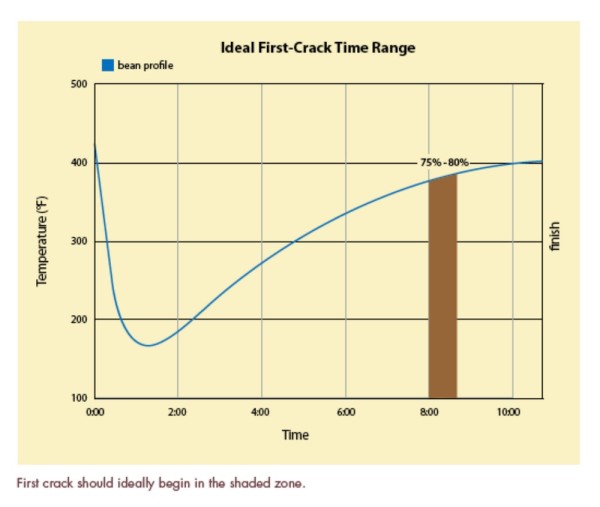by Scott Rao
Over the past decade as a consultant, I’ve had the opportunity to cup thousands of roast batches from more than two dozen machines, and to compare those batches’ roast data to their cupping results. Upon focusing on only the most stellar, memorable batches, a few patterns became clear: One was that first crack* began at between 75%–80% in all the great batches. Put another way, “development time” was between 20%–25% of total roast time.
For six years I’ve been waiting to taste a delicious, sweet, well-developed coffee from a roast batch in which first crack began outside of that range. I have yet to find it. This ideal “development-time ratio” (DTR) has been valid for all roast degrees and roast times I’ve experienced. To be fair, I don’t often cup roasts dropped well before the end of first crack or well after the onset of second crack, so I won’t assume the ratio is valid for those roast levels.
(related: A Quantitative Description of the Sounds of Cracks During Roasting)
Roasters have historically focused on “development time” (defined as the time from the onset of first crack until the end of a roast) and discussed it in isolation. For example, roasters have frequently asked me to taste a coffee and then said “development time was three minutes.” To me, that piece of roast data is relatively meaningless out of the context of the total roast time.
I recommend roasters focus on the DTR rather than nominal development time. When roasters manipulate development time without considering it in the context of the total roast time, they often create baked flavors and destroy sweetness.
While achieving a 20%–25% DTR doesn’t guarantee a brilliant roast, it seems to be a prerequisite for a successful roast. Think of it as a marker of balance: if a roast begins very fast and ends slowly or vice versa, the DTR will be outside of the 20%–25% range. I’ve had roasters protest that they roast successfully outside of that range, but none of them have ever, to my knowledge, verified full roast development both organoleptically and objectively — for example, with a refractometer. On the other hand, in my sample of thousands of batches tested for development by smell, taste, and refractometer, every successful roast’s DTR was within that range.
*I mark the beginning of first crack as the moment I hear more than one or two isolated cracks. If you measure the beginning of first crack differently, your results may differ.
Scott Rao
Scott Rao has been in the coffee business for 20 years as a cafe owner, roaster, author, and consultant. Scott has written four books, including "The Professional Barista's Handbook" and most recently "The Coffee Roaster's Companion." When he's not writing, Scott is usually training roasters or sipping Sencha tea in the corner of a cafe. You can contact Scott or view his books at www.scottrao.com.
Comment
7 Comments
Comments are closed.







Hi Scott,
Is your experience that this DTR is necessary for successful ‘espresso’ roasts or does it accommodate the prevalent ‘lighter’ roasting styles we’re riding the wave of at the moment ?
Nice snippet of info and can’t wait to read more in your new book. Any idea where it will be available in the UK and when ?
cheers
dave
Reply to Dave’s comment:
IMO it’s just as or even more important in light roasts. The biggest flaw in many roasters light roasts is under development resulting in cups to varying degress over acidic, grassy and/or lacking sweetness.
That 8 minute to first crack and 2-3 minutes to finish really brought out the fruits and acids!
For very small home roast, say 1/2 pound, can this be reduced to 8 minutes with first crack at the 6 minute 20 second mark?
I find the terminology here misleading. The use of “-Time Ratio” is inconsistent with how Scott defines DTR. For example, the listed “20-25%” is a percentage of total time and not a ratio. Later he refers to percent completion of roast time, again not a ratio.
I recommend either listing DTR in ratio (e.g. 1:4), or coming up with a less catchy acronymn, consistent with the intuitive use of percentages of a whole. Perhaps “DRT” for “development over roast time”?
There are just so many variables – I assume you are roasting for cupping? All beans are different and it depends on what you mean by ‘successful’ roasts. What size batch are we talking about here? and I notice that your charge temp on the graph starts at 415-420… I may have to buy your book to see what all the fuss is about…
I’ve been roasting for 20 years. Reading this makes me dumber for thinking about it. If u don’t roast and you don’t love it leave it to the people that do. If you love it. Roast it cup it love it, improve it and to hell with this bullsh#t. It’s art and science and if you miss the art part you’ve missed the point in life.